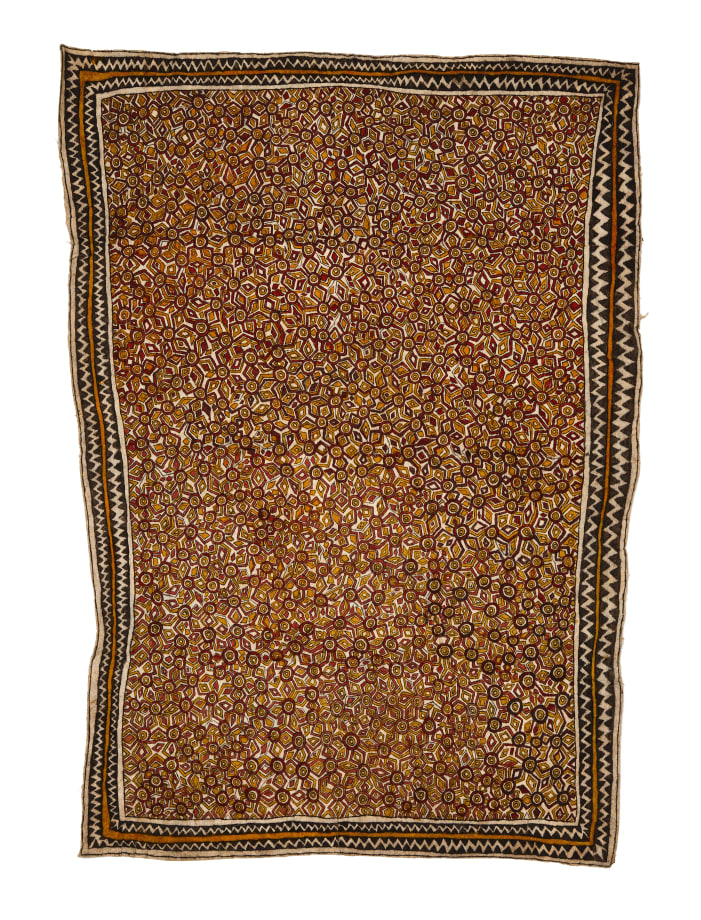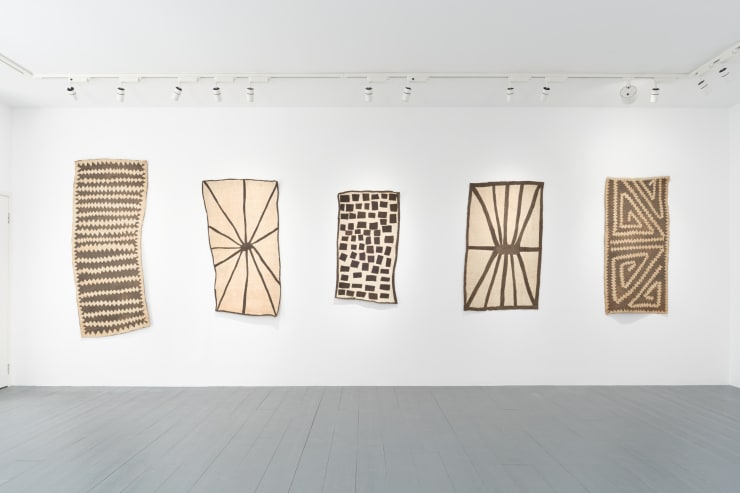" These nioge convey something essential to human existence; a deference to elders and ancestry, a respect for the natural world and an interconnectedness with one another."
- Jennifer Guerrini Maraldi
LONDON, 19 April, 2023 - JGM Gallery presents Ömie, a group exhibition of 17 artists working on nioge (barkcloth), in association with Ömie Artists.
The Ömie reside in the remote inland mountains of Oro Province in Papua New Guinea. It is here that they create and decorate nioge (barkcloth) in a form of expression where the utilitarian, artistic and sacred coexist. Traditionally, nioge have been used ceremonially and as everyday clothing, however, in more recent years they have also been made for purely artistic appreciation. Primarily, the artists are women and barkcloth painting is their domain, however, there are some rare instances of male practitioners who were formally trained by their mothers.
The process of creating nioge is a time-consuming process that involves many stages and requires a high degree of skill. First, the bark is collected from certain trees, predominantly from the paper mulberry tree but also from fig and hibiscus species. The inner bark is harvested from the tree and separated from the outer bark. The inner bark is then rinsed and soaked in water for several hours, softening it before the next stage. It is then laid on a flat surface and beaten with a wooden mallet, this time to make it thinner and more pliable.
The pigments and dyes used to paint and dye the barkcloths (predominantly reds, yellows, greens, blacks and deep greys) are all procured from the abundant rainforests that surround the Ömie, such as ferns, fruits, leaves, coconut charcoal, tree sap and volcanic mud. The intricate designs are either painted onto the barkcloth using strong grasses or fashioned wooden sticks (called ije), with frayed betelnut husk brushes. The completed nioge is then dried in the sun, sometimes over several days. Some barkcloths with the most ancient origins have a minimal aesthetic, and the process involves dyeing the barkcloth in volcanic river mud. The designs are then appliquéd using a fine bat-wing bone needle.
The styles of the exhibiting artists vary vastly, from the densely patterned and hallucinogenic aesthetic of the late Albert Sirimi (Nanati), to the more reduced and monochromatic designs of Patricia Warera. What unites all the work, however, is an expression of Ömie culture. As Ömie Artists Manager, Brennan King, states, there is "... the sense of one united cultural identity... this can be seen and sensed in Ömie barkcloth paintings - despite the great diversity of symbolism there is a distinct 'Ömie essence'."
Nioge can be conceived as a library of sorts, containing ancient information about Ömie cosmology, their belief systems and the natural world in general. A Western analogue, though not an exact equivalent, would be illuminated manuscripts. There is also a seriousness attached to their construction and only particularly refined barkcloths by accomplished artists are exhibited by Ömie Artists. Moreover, the artists must first master the inherited clan designs of their ancestral lineage. Until they reach a certain level of proficiency and social status, they cannot use their uehore (wisdom) to create new designs. The Ömie's artistic practice is also, in part, informed by the Ömie creation story, in which the first woman, Suja, created a barkcloth and dyed it with red volcanic river mud to celebrate her new-found fertility. There is thus a ritualistic aspect to the making of barkcloths and their creation is, in some sense, a re-enactment of Suja's actions. Implicit in this is also a celebration of fecundity and the creative forces of nature.
Exhibiting artists include Albert Sirimi (Nanati), Brenda Kesi (Ariré), Elizabeth Guho (Owkeja), Faith Jina'emi (Iva), Mala Nari (Matosi), Wilma Rubuno (Lamay), Pauline-Rose Hago (Derami), Rosemon Hinana, Jessie Bujava (Kipora), Diona Jonevari (Suwarari), Magdalene Bujava (Kolahi), Pennyrose Sosa, Elvina Naumo (Ebahino), Jean Niduvé (Urihö), Barbara Rauno (Inasu), Maureen Sirimi (Jafuri) and Patricia Warera (Matomguo).
-
 Elvina Naumo (Ebahino)Savani degirani, siha’e ohu’o dahoru’e, 2022Natural pigments on nioge (barkcloth)143cm x 103.5cm
Elvina Naumo (Ebahino)Savani degirani, siha’e ohu’o dahoru’e, 2022Natural pigments on nioge (barkcloth)143cm x 103.5cm -
 Diona Jonevari (Suwarari)Se’a hu’e, dahoru’e, bubori anö’e, vë’i ija ahe, odunaigö’e, jö’o sor’e, sabu ahe, vinohu’e ohu’o siha’e, 2021Natural pigments on nioge (barkcloth)164cm x 70.5cm
Diona Jonevari (Suwarari)Se’a hu’e, dahoru’e, bubori anö’e, vë’i ija ahe, odunaigö’e, jö’o sor’e, sabu ahe, vinohu’e ohu’o siha’e, 2021Natural pigments on nioge (barkcloth)164cm x 70.5cm -
 Jessie Bujava (Kipora)Obohutaigu’e, sin’e soré (siha’e, taigu taigu’e, jö’o sor’e), visu anö’e, vavor’e daje, bubori anö’e ohu’o ori sigé, 2022Natural pigments on nioge (barkcloth)124cm x 57cm
Jessie Bujava (Kipora)Obohutaigu’e, sin’e soré (siha’e, taigu taigu’e, jö’o sor’e), visu anö’e, vavor’e daje, bubori anö’e ohu’o ori sigé, 2022Natural pigments on nioge (barkcloth)124cm x 57cm -
 Barbara Rauno (Inasu)Kukuhon’e soré (nuni’e, taigu taigu’e, jö’o sor’e ohu’o ori sigé), 2022Natural pigments on nioge (barkcloth)123cm x 59cm
Barbara Rauno (Inasu)Kukuhon’e soré (nuni’e, taigu taigu’e, jö’o sor’e ohu’o ori sigé), 2022Natural pigments on nioge (barkcloth)123cm x 59cm -
 Albert Sirimi (Nanati)Ujavu am’e (guai); taigu taigu’e; juburi anö’e; ahéhuruvë'e; nuni’e; ohu’o sabu ahe, 2012Natural pigments on nioge (barkcloth)160cm x 65cm
Albert Sirimi (Nanati)Ujavu am’e (guai); taigu taigu’e; juburi anö’e; ahéhuruvë'e; nuni’e; ohu’o sabu ahe, 2012Natural pigments on nioge (barkcloth)160cm x 65cm -
 Pennyrose SosaHartu’e, sabu ahe ohu’o dahoru’e, 2016Natural pigments on nioge (barkcloth)106cm x 65.5cm
Pennyrose SosaHartu’e, sabu ahe ohu’o dahoru’e, 2016Natural pigments on nioge (barkcloth)106cm x 65.5cm -
 Magdalene Bujava (Kolahi)Sogua’e (sodireje, siha’u’e, roriré, venimomö’e, uejobibgé, modahisu’e, mahuva’ojé, sin’e sore, jaji’e ohu’o areté), 2022Natural pigments on nioge (barkcloth)103cm x 53cm
Magdalene Bujava (Kolahi)Sogua’e (sodireje, siha’u’e, roriré, venimomö’e, uejobibgé, modahisu’e, mahuva’ojé, sin’e sore, jaji’e ohu’o areté), 2022Natural pigments on nioge (barkcloth)103cm x 53cm














